Proximal Humerus Fracture Classifications
- Proximal Humerus Fracture: AO Classification
- Proximal Humerus Fracture: Habermeyer Classification
- Proximal Humerus Fracture: Neer’s Classification
- Sequelae of surgery of proximal humerus fractures: Boileau classification
- Predictors of humeral head ischaemia: Hertel
- Hertel’s Binary or Lego description system for proximal Humerus fractures
Proximal Humerus Fracture: AO Classification
Müller M, In: Manual of internal fixation, 118-125, 1988
A: Extra-articular unifocal fracture
A1 Extra-articular unifocal tuberosity fracture
.1 Gr Tuberosity, not displaced
.2 Gr Tuberosity, displaced
.3 associated with GH dislocation
A2 Extra-articular unifocal impacted metaphyseal fracture
.1 no frontal displacement
.2 varus malalignment
.3 valgus malalignment
A3 Extra-articular unifocal non-impacted metaphyseal fracture
.1 simple, angulated
.2 simple, translated
.3 multifragmentary
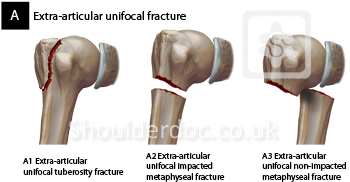
B: Extra-articular bifocal fracture
B1 Extra-articular bifocal fracture with metaphyseal impaction
.1 Lateral and Gr tuberosity
.2 Medial and lesser tuberosity
.3Posterior and Gr tuberosity
B2 Extra-articular bifocal fracture without metaphyseal impaction
.1 without rotational displacement
.2 with rotational displacement
.3 multifrag metaphyseal with one of the tuberosities involve
B3 Extra-articular bifocal fracture with GH dislocation
.1 Vertical cervical line, Gr Tuberosity intact, Ant-med dislocation
.2 Vertical cervical line, Gr Tuberosity fracture, Ant-med dislocation
.3 Lesser tuberosity fracture, posterior dislocation
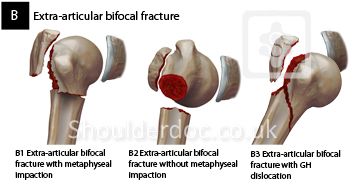
C: Articular Fracture
C1 Slightly displaced
.1 cephalotubercular, valgus alignment
.2 cephalotubercular, varus alignment
.3 anatomical neck
C2 Impacted and significantly displaced
.1 cephalotubercular, valgus alignment
.2 cephalotubercular, varus alignment
.3 Transcephalic and tubercular, varus alignment
C3 Dislocated
.1 anatomical neck
.2 anatomical neck and tuberosities
.3 cephalotubercular fragments
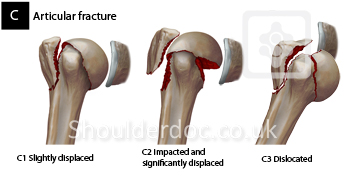
Proximal Humerus Fracture: Habermeyer Classification
Type 0: One part, non-dislocated
Type A: Two part fractures
A1: Gr tuberosity avulsion
A2: Lesser tuberosity avulsion
Type B: Surgical neck
B1: 2 part fracture
B2: 3 part, surg neck and one tuberosity
B3: 4 part, surg neck and both tuberosity
Type C: Anatomical neck fracture, high risk of head AVN
C1: 2 part fracture
C2: 3 part, anat neck and one tuberosity
C3: 4 part, anat neck and both tuberosity
Type X: Anterior or posterior fracture dislocation
Proximal Humerus Fracture: Neer’s Classification
Neer II,CS, JBJS (A), 52: 1077-1089, 1970
Minimally displaced one part fractures
No segment displaced > 1cm or angulated > 45 deg
Two part fracture of anatomical neck, articular segment displaced
High risk of AVN
Two part fracture of the surgical neck with shaft displacement:
-Impacted- >45 deg angulation, apex anterior
-Unimpacted- shaft dispalced antero-med, head neutral
-Comminuted- fragmented upper shaft
Two part greater tuberosity displacement
Two part lesser tuberosity displacement
Three part displacements: one tuberosity remains attached to the head
Greater tuberosity displacement
Lesser tuberosity displacement
Four part fractures, fracture dislocation and head splitting fractures:
articular segment displaced out of contact with glenoid, no soft tissue attachment, no tuberosity contact
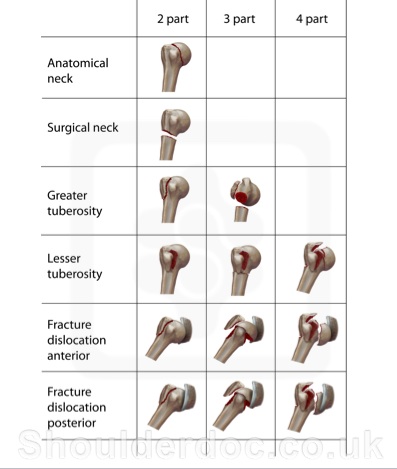
Sequelae of surgery of proximal humerus fractures: Boileau classification
Boileau et al, JSES,10: 299-308, 2001
Type 1: Humeral head collapse or necrosis, minimal tuberosity malunion
Type 2: locked dislocations of fracture dislocations
Type 3: surgical neck non-union
Type 4: severe tuberosity malunion
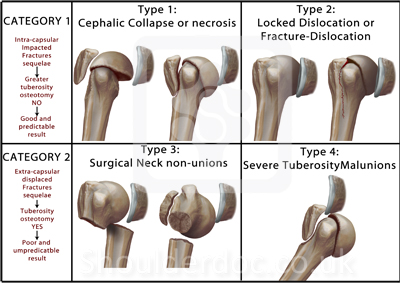
Predictors of humeral head ischemia : Hertel
R. Hertel, A. Hempfing, M. Stiehler, M. Leunig. JSES, Volume 13, 2004, Pages 427-433
Good predictors of ischemia:
- Length of metaphyseal head extension (accuracy 0.84 for calcar segments <8 mm)
- Integrity of the medial hinge (accuracy 0.79 for disrupted hinge)
- Basic fracture pattern (accuracy 0.7 for fractures comprising the anatomic neck)
Poor predictors of ischemia
- Angular displacement of the head (accuracy 0.62 for angulations over 45 deg)
- Extent of displacement of the tuberosities (displacement over 10 mm: accuracy 0.61)
- Gleno-humeral dislocation (accuracy 0.49)
- Head-split components (accuracy 0.49)
Hertel’s Binary or Lego description system for proximal Humerus fractures
R. Hertel, A. Hempfing, M. Stiehler, M. Leunig. JSES, Volume 13, 2004, Pages 427-433
Five basic fracture planes:
1. between the greater tuberosity and the head
2. between the greater tuberosity and the shaft
3. between the lesser tuberosity and the head
4. between the lesser tuberosity and the shaft
5. between the lesser tuberosity and the greater tuberosity
12 basic fracture patterns:
6 possible fractures dividing the humerus into two fragments,
5 possible fractures dividing the humerus into three fragments,
Single fracture pattern dividing the humerus into four fragments
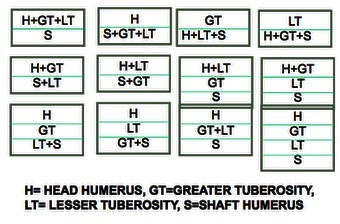
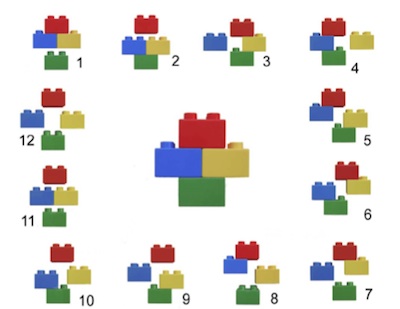


 Top
Top